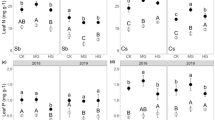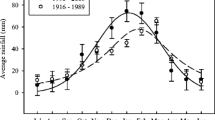Abstract
Aims
To determine the impact of long-term rabbit and sheep grazing on Salix repens N status (green and abscised leaf N content and C:N ratio), internal N dynamics and soil N supply rate in dune slacks.
Methods
Herbivore exclosures were erected in dune slacks at Ainsdale Sand Dunes NNR, creating three grazing treatments: rabbit grazing; rabbits excluded for 36 years; rabbit grazing followed by sheep and rabbit grazing for 18 years. Soil N supply rate was analysed using ion exchange membranes; leaf N dynamics of S. repens were measured over one summer.
Results
Soil N supply rate was higher in ungrazed plots. There was no difference in green leaf NMASS or C:N ratio between treatments, but N dynamics differed. Adding sheep to existing rabbit grazing reduced S. repens N resorption efficiency (REFF) from 67 to 37 %; excluding rabbits had no impact. Litter NMASS was lower and C:N ratio higher in ungrazed plots.
Conclusions
Grazing can impact significantly on leaf N resorption, but this impact depends on the grazing regime.






Similar content being viewed by others
References
Abramoff M, Magalhaes P, Ram S (2004) Image processing with ImageJ. Biophoton Int 11:36–42
Aerts R (1996) Nutrient resorption from senescing leaves of perennials: are there general patterns? J Ecol 84:597–608
Bakker ES, Knops JMH, Milchunas DG et al (2009) Cross-site comparison of herbivore impact on nitrogen availability in grasslands: the role of plant nitrogen concentration. Oikos 118:1613–1622. doi:10.1111/j.1600-0706.2009.17199.x
Bardgett RD, Wardle DA (2003) Herbivore-mediated linkages between aboveground and belowground communities. Ecology 84:2258–2268. doi:10.1890/02-0274
Bobbink R, Hettelingh J (2011) Review and revision of empirical critical loads and dose–response relationships. Coordination Centre for Effects, National Institute for Public Health and the Environment, Bilthoven
Chapman SK, Langley JA, Hart SC, Koch GW (2006a) Plants actively control nitrogen cycling: uncorking the microbial bottleneck. New Phytol 169:27–34
Chapman SK, Whitham T, Powell M (2006b) Herbivory differentially alters plant litter dynamics of evergreen and deciduous trees. Oikos 114:566–574
Cherif M, Loreau M (2013) Plant – herbivore – decomposer stoichiometric mismatches and nutrient cycling in ecosystems. Proc R Soc B Biol Sci 280:20122453. doi:10.1098/rspb.2012.2453
Clarke D, Sanitwong Na Ayutthaya S (2009) Predicted effects of climate change, vegetation and tree cover on dune slack habitats at Ainsdale on the Sefton Coast, UK. J Coast Conserv 14:115–125. doi:10.1007/s11852-009-0066-7
Cornwell WK, Cornelissen JHC, Amatangelo K et al (2008) Plant species traits are the predominant control on litter decomposition rates within biomes worldwide. Ecol Lett 11:1065–1071
Demment MW, Van Soest PJ (1985) A nutritional explanation for body-size patterns of ruminant and nonruminant herbivores. Am Nat 125:641–672
Frank D, Evans R (1997) Effects of native grazers on grassland N cycling in Yellowstone National Park. Ecology 78:2238–2248
Hangs R, Greer K, Sulewski C (2004) The effect of interspecific competition on conifer seedling growth and nitrogen availability. Can J For Res 34:754–761
Hester AJ, Millard P, Baillie GJ, Wendler R (2004) How does timing of browsing affect above- and below-ground growth of Betula pendula, Pinus sylvestris and Sorbus aucuparia? Oikos 3:536–550
Hobbs N (1996) Modification of ecosystems by ungulates. J Wildl Manag 60:695–713
Houston J (2004) Coastal heritage: an introduction to the history of the Sefton Coast. http://www.seftoncoast.org.uk
IBM Corp. (2011) IBM SPSS Statistics for Windows
Jaramillo V, Detling J (1992) Cattle grazing of simulated urine patches in North American grassland. J Appl Ecol 29:9–13
Jones MLM, Wallace HL, Norris D et al (2004) Changes in vegetation and soil characteristics in coastal sand dunes along a gradient of atmospheric nitrogen deposition. Plant Biol 6:598–605. doi:10.1055/s-2004-821004
Kielland K, Bryant JP, Ruess RW (1997) Moose herbivory and carbon turnover of early successinal stands in interior Alaska. Oikos 80:25–30
Killingbeck K (1996) Nutrients in senesced leaves: keys to the search for potential resorption and resorption proficiency. Ecology 77:1716–1727
Kobe RK, Lepczyk CA, Lyer M (2005) Resorption efficiency decreases with increasing green leaf nutrients in a global data set. Ecology 86:2780–2792
Milchunas D, Lauenroth W (1993) Quantitative effects of grazing on vegetation and soils over a global range of environments. Ecol Monogr 63:327–366
Millard P (1996) Ecophysiology of the internal cycling of nitrogen for tree growth. Z Pflanzenernähr Bodenkd 159:1–10
Millard P, Hester A, Wendler R, Baillie G (2001) Interspecic defoliation responses of trees depend on sites of winter nitrogen storage. Funct Ecol 15:535–543
Millett J, Edmondson S (2013) The impact of 36 years of grazing management on vegetation dynamics in dune slacks. J Appl Ecol 50:1367–1376. doi:10.1111/1365-2664.12113
Millett J, Millard P, Hester AJ, McDonald AJS (2005) Do competition and herbivory alter the internal nitrogen dynamics of birch saplings? New Phytol 168:413–422. doi:10.1111/j.1469-8137.2005.01510.x
Mithöefer A, Boland W (2012) Plant defense against herbivores: chemical aspects. Annu Rev Plant Biol 63:431–450
Olofsson J, de Mazancourt C, Crawley MJ (2007) Contrasting effects of rabbit exclusion on nutrient availability and primary production in grasslands at different time scales. Oecologia 150:582–589. doi:10.1007/s00442-006-0555-4
Parsons A, Newman J, Penning P et al (1994) Diet preference of sheep: effect of recent diet, physiological state and species abundance. J Anim Ecol 63:465–478
Pastor J, Dewey B, Christian DP (1996) Carbon and nutrient mineralization and fungal spore composition of fecal pellets from voles in Minnesota. Ecography 19:52–61
Ritchie M, Tilman D, Knops M (1998) Herbivore effects on plant and nitrogen dynamics in oak savannah. Ecology 79:165–177
Schrama M, Veen GFC, Bakker ESL et al (2013) An integrated perspective to explain nitrogen mineralization in grazed ecosystems. Perspect Plant Ecol Evol Syst 15:32–44. doi:10.1016/j.ppees.2012.12.001
Silla F, Escudero A (2003) Uptake, demand and internal cycling of nitrogen in saplings of Mediterranean Quercus species. Oecologia 28–36. doi: 10.1007/s00442-003-1232-5
Sirontnak J, Huntley N (2000) Direct and indirect effects of herbivores on nitrogen dynamics: voles in riparian areas. Ecology 81:78–87
Stark S, Grellmann D (2002) Soil microbial responses to herbivory in an Arctic tundra heath at two levels of nutrient availability. Ecology 83:2736–2744
Stark S, Männistö MK, Eskelinen A (2014) When do grazers accelerate or decelerate soil carbon and nitrogen cycling in tundra? A test of theory on grazing effects in fertile and infertile habitats. Oikos 24:593–602. doi:10.1111/oik.01355
Van der Wal R, Bardgett R, Harrison H, Stien A (2004) Vertebrate herbivores and ecosystem control: cascading effects on tundra ecosystems. Ecography 27:242–252
Van Heerwaarden LM, Toet S, Aerts R (2003) Nitrogen and phosphorus resorption efficiency and proficiency in six sub-arctic bog species after 4 years of nitrogen fertilization. J Ecol 91:1060–1070. doi:10.1046/j.1365-2745.2003.00828.x
Vergutz L, Manzoni S, Porporato A, Novais RF, Jackson RB (2012) Global resorption efficiencies and concentrations of carbon and nutrients in leaves of terrestrial plants. Ecol Monogr 82:205–220
Wardle D, Bonner K, Barker G (2002) Linkages between plant litter decomposition, litter quality, and vegetation responses to herbivores. Funct Ecol 16:585–595
Wardle DA, Bardgett RD, Klironomos JN et al (2004) Ecological linkages between aboveground and belowground biota. Science 304:1629–1633
Yasumura Y, Onoda Y, Hikosaka K, Hirose T (2005) Nitrogen resorption from leaves under di erent growth irradiance in three deciduous woody species. Plant Ecol 29–37. doi: 10.1007/s11258-004-2485-8
Acknowledgments
This study was funded by the Botanical Society of the British Isles. The manuscript was greatly improved by the comments of three anonymous reviewers and Harry Olde Venterink.
Conflict of interest
The authors have no conflicts of interest.
Author information
Authors and Affiliations
Corresponding author
Additional information
Responsible Editor: Harry Olde Venterink.
Rights and permissions
About this article
Cite this article
Millett, J., Edmondson, S. The impact of 36 years of grazing management on soil nitrogen (N) supply rate and Salix repens N status and internal cycling in dune slacks. Plant Soil 396, 411–420 (2015). https://doi.org/10.1007/s11104-015-2628-9
Received:
Accepted:
Published:
Issue Date:
DOI: https://doi.org/10.1007/s11104-015-2628-9




